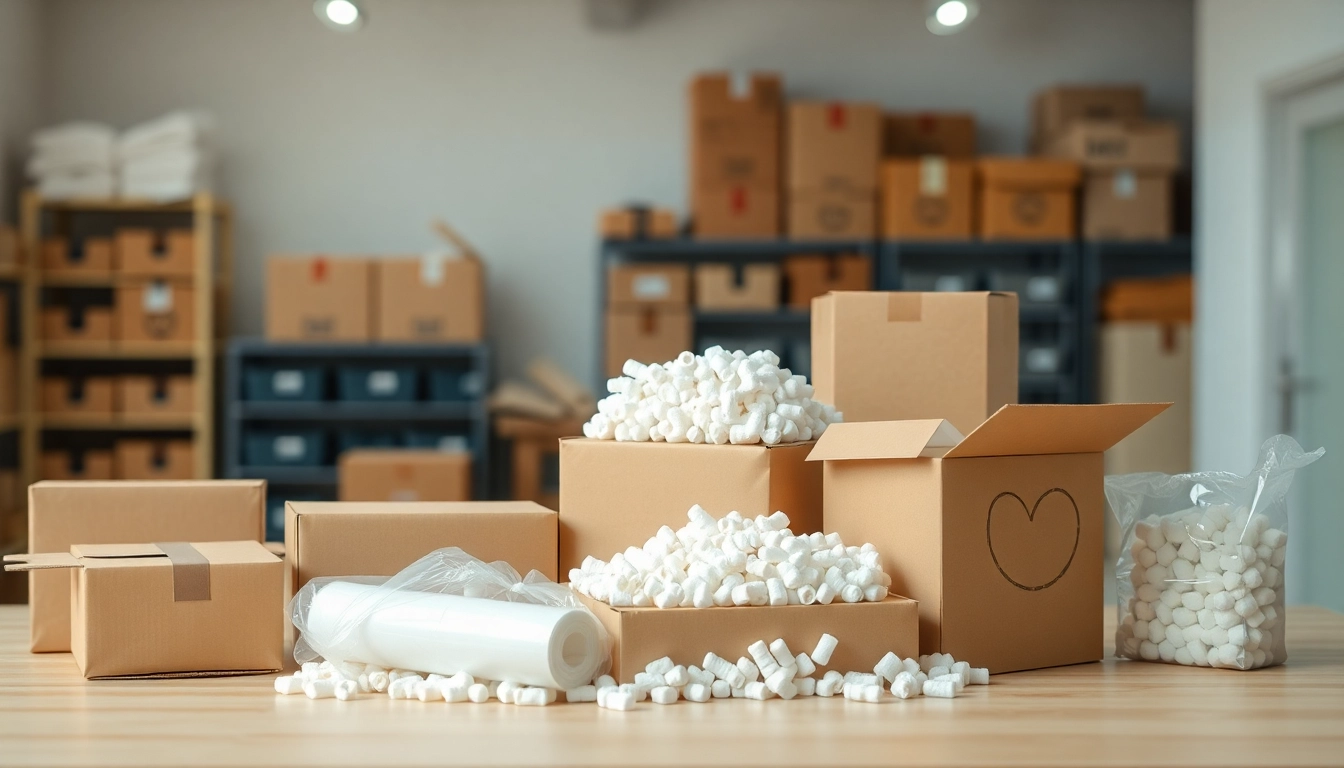
Understanding Packing Materials
What Are Packing Materials?
Packing materials are materials used to protect and secure items during storage or transportation. Their primary role is to ensure that products arrive at their destination in the same condition they were in when shipped. These materials can range from simple cardboard boxes to sophisticated foam inserts designed for specific products. Each type of packing material serves its unique purpose, tailored to different items and shipping conditions.
The Importance of Quality Packing Supplies
Using quality packing supplies is vital for several reasons:
- Protection: High-quality materials minimize the risk of damage during transit.
- Cost-Effectiveness: Investing in durable materials can save money in the long run by reducing the frequency of replacements or claims due to damaged items.
- Brand Image: Well-packed products portray professionalism and care, enhancing customer satisfaction and loyalty.
- Compliance: Certain industries require adherence to specific packing standards; using the right materials can ensure compliance.
Types of Packing Materials Available
There are various types of packing materials, each suited for different needs:
- Cardboard Boxes: Perhaps the most common type, available in various sizes and strengths for all types of shipping needs.
- Bubble Wrap: Ideal for fragile items, providing cushioning against impacts during transport.
- Packing Peanuts: Lightweight and effective at filling void spaces in boxes, preventing items from shifting.
- Foam Inserts: Custom-fitted packaging that protects high-value items from damage.
- Padded Mailers: Often used for smaller or less fragile items, they combine a rigid outer layer with cushioning material.
- Stretch Film: Used to wrap pallets of products, securing them for transport.
Choosing the Right Packing Materials for Your Needs
Factors to Consider When Selecting Packing Materials
When selecting packing materials, several factors should be considered:
- Item Type: Determine the nature of the item. Fragile items will require more protective materials compared to non-fragile ones.
- Weight: Heavier items require sturdier boxes and materials to prevent breakage.
- Shipping Distance: Longer distances may require more robust packing to withstand different handling and environmental conditions.
- Cost: Consider your budget while ensuring that quality is not compromised.
Common Mistakes to Avoid
Avoid these common pitfalls when choosing packing materials:
- Using Inadequate Materials: Compromising quality for cost can lead to damaged goods.
- Overpacking: Excess material can lead to increased shipping costs, while inadequate packing can lead to damage.
- Underestimating Package Size: Incorrectly sized packages can affect shipping rates and delivery times.
- Ignoring Environmental Impact: Failing to consider eco-friendly alternatives can negatively affect your brand image.
Best Practices for Packing Effectively
To enhance your packing efficiency and effectiveness, consider these best practices:
- Use the Right Box Size: Ensure that the box fits the items snugly, minimizing movement during shipping.
- Label Properly: Clear labeling can help ensure that packages are handled correctly.
- Seal Correctly: Use high-quality tape to secure boxes adequately.
- Fill Empty Spaces: Use packing peanuts or air pillows to fill voids in boxes, preventing movement.
Cost-Effective Packing Solutions
Where to Buy Affordable Packing Materials
Finding affordable packing materials doesn’t have to be a daunting task. Many local hardware stores, online retailers, and specialized packing supply vendors have cost-effective solutions. Packing materials from trusted suppliers often offer better bulk pricing and deals.
DIY Packing Materials: Creative Alternatives
Innovative packing doesn’t always require purchasing materials. Consider these DIY alternatives:
- Old Newspapers: Crumpled newspapers can work effectively as void fillers and cushioning.
- Clothing and Linens: Strategically using old clothes or bedding can provide protection while being eco-friendly.
- Cardboard Dividers: Create dividers from old cardboard to keep multiple items organized inside a single box.
- Glass Jars: For small, fragile items, repurposed jars can serve as excellent protective containers.
Choosing Bulk Options for Savings
Buying packing materials in bulk can lead to significant cost savings:
- Volume Discounts: Many suppliers offer discounts for large quantity purchases, reducing per-unit costs.
- Emergency Stock: Maintaining additional materials means you’ll always be ready for shipments without last-minute purchases.
- Fewer Reorders: Bulk buying reduces the frequency of orders, saving time and shipping costs.
Innovations in Packing Materials
Eco-Friendly Packing Materials to Consider
As sustainability becomes increasingly important, eco-friendly packing materials are gaining traction:
- Biodegradable Peanuts: Made from natural starch, they dissolve in water and are compostable.
- Recycled Paper: Using recycled paper products minimizes waste and supports recycling initiatives.
- Mushroom Packaging: Innovatively created from mycelium, this material is fully compostable and biodegradable.
- Reusable Containers: Consider durable containers that can be returned and reused for multiple shipments.
Technological Advancements in Packing Supplies
Next-gen packing materials use technology to enhance efficiency and protection:
- Smart Packaging: Embedded sensors can provide data about the condition of a package, such as temperature and humidity levels during transit.
- Self-Sealing Technology: Automated sealing systems minimize time spent on packing.
- 3D Packing Design: Software can optimize packing arrangements to reduce material usage and space.
Future Trends in Packing Materials
The future will likely bring about more innovations in packing materials:
- Advanced Biodegradables: Research is ongoing into materials that break down faster without leaving harmful residues.
- Custom Packaging Solutions: More businesses are seeking tailored solutions for unique product shapes and sizes.
- Augmented Reality Packing: Technology may allow customers to visualize packing solutions for their items prior to shipping.
Measuring the Effectiveness of Your Packing
How to Assess Packing Material Performance
Evaluating the effectiveness of your packing materials is critical for maintaining quality control:
- Damage Rates: Monitor the number of items damaged upon arrival as a metric of packing effectiveness.
- Customer Returns: Analyzing return data can help identify whether packing materials contribute to dissatisfaction.
- Cost Analysis: Compare spending on shipping claims versus packaging investments to determine the cost-effectiveness of various materials.
Customer Feedback and Its Impact
Utilizing customer feedback can inform your packing strategy:
- Surveys: Gather feedback concerning the condition of items upon receipt.
- Social Media Monitoring: Track mentions of packaging quality to gain insights from a broader audience.
- Engagement: Encourage customers to share their unboxing experiences on social media platforms.
Adjusting Your Strategy Based on Results
Adapting your packing strategy based on performance evaluations is essential:
- Testing and Iteration: Test new packing materials and methods periodically to identify improvements.
- Communicate with Suppliers: Work closely with suppliers to stay updated on new products that may offer better protection or cost-efficiency.
- Training Employees: Equip your team with updated knowledge on efficient packing techniques and materials.






